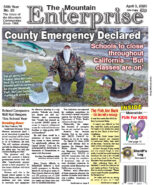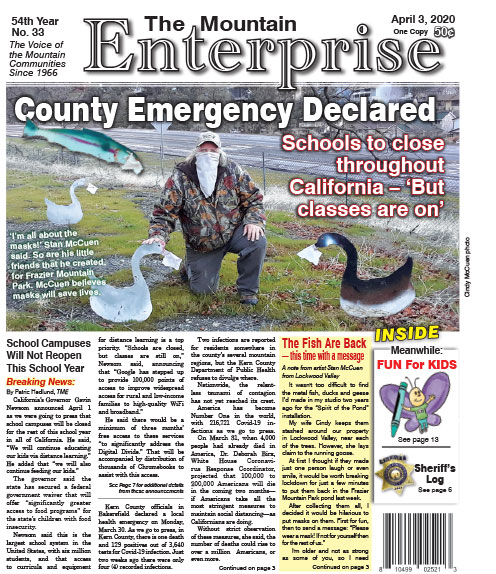The Hometown Publishing Style Guide
Welcome. We are honored to have you as a contributor. The Mountain Enterprise has been serving the Mountain Communities for going on 55 years. That is because you and your neighbors keep it lively and informative with your contributions.
Publishers give style guides to writers because it is easier for readers to focus on the meaning of your story when the newspaper is consistent in its punctuation, spelling, grammar and diction. Please use this guide in your writing. It will help you get your story to the public quickly and accurately. Have fun. We look forward to seeing your stories.
FORMAT AND CONTENT GUIDELINES
Length and Deadlines: Keep your article to 200-250 words if it is a meeting announcement. Reports may vary, in consultation with the editor. Letters to the editor average 150 words. If you send a 7,000-word dissertation without advance arrangement with the editor you may wait for a very long time to see it printed. News and opinion pieces are 400-500 words. Deadlines: Editorial content (stories and photos) are due Thursday at 5 p.m. for The Mountain Enterprise. Send stories to Editor@MountainEnterprise.com. Send calendar events by Thursday at 5 p.m. to Calendar@MountainEnterprise.com . All advertising is handled by a separate section of the business. Write to advertising@MountainEnterprise.com .
Edit: Avoid repetition. Say something well and say it once—not multiple times in the same piece. Do not send your first draft. Read the story, check your spelling and tighten up the writing. Do a second draft, or more.
Lead Sentence: Start your story with a “news lead.” That is the aspect of the event that the general public will find most interesting and timely. More people will read the story if you have a compelling lead sentence.
Content: Your story should be interesting and informative to the general public—not just your club. As a newspaper, we are different from your newsletter. Re-read your story. Will someone who has never heard of your organization understand the story? Strip out the jargon. Use interesting and energetic standard English.
On another note, sometimes we receive angry screeds from people wishing to bring harm to others. Please remember that your statements must pass editorial and journalistic standards. We will not print unsupported or libelous statements. Facts are powerful. Use facts rather than insults or innuendo. If you name a person or group in an OpEd, we will invite those named to respond with their own statement.
Fact Check: Review your report and check the facts: Be sure all names are spelled correctly and your facts are straight. Are the dates and times accurate? Review each fact twice and double-check it with an independent source.
If the newspaper editor finds factual errors, your story is likely to go to the bottom of the week’s priority list because it represents extra work for our staff, and we may not have time to research and correct your story for you.
Proofread Your Submission: Ask someone else to read your write-up prior to sending it to us. Correct errors. Help us help you to make a crisp and understandable presentation to the public.
Always Include Your Name, Email and Telephone Numbers: All submissions to our newspapers must be signed or we will not print them. Include telephone numbers (two—cell and home) where you can be quickly reached should we come upon a question at deadline. Also include your email address. The contact information is for the editor’s use only. We do not publish your phone number unless it is part of your story.
Your Byline: Please include your name and your title with the organization you are writing about. We also need your place of residence on the mountain (i.e. Lake of the Woods, Frazier Park, Lebec, Gorman, Pine Mountain, Neenach, Cuyama). We do not print anonymous letters.
Photos: If you send photos, be sure to tell us who took them and who is shown in the photo (left to right) along with what is happening, and where. Photos should be between 250 KB and 5 MB in .jpg format. Small images from the internet do not print well.
Stylebook Guidelines Summary
Standard Notation of Time: 10 a.m., 10:15 a.m. [not 10 AM or 10am or 10:00 AM].
Dates Are Simple Dates, No Embellishment: April 27 [not 27th]. When a day of the week is spelled out, the month is abbreviated: “Friday, Jan. 13 was an eventful day for El Tejon School.” It is 1950s not 1950’s.
Use Word Wrap, Not Hard Returns: Use word wrap in your email and word processor. If you make carriage returns at the end of each line of text it may add extra time to the editor’s and proofreaders’ jobs. Hard returns must be plucked out. It may make the difference between your submission being used or put aside because of lack of time at deadline. Submissions as plain text in email rather than an attachment are welcomed.
One Space After a Period: At the end of each sentence use only one space, not two. As above, more than one space after a period causes extra proofreading and correction time.
The Dash as Punctuation: If you use a dash in your punctuation — such as this — please use the “em” dash (option+shift+hyphen on a Mac).
No Capital Letters for Emphasis: Capitals are occasionally used as category titles, but we do not print words spelled in capital letters as a form of emphasis within stories. We do sometimes use italics for emphasis. Please do not send us stories or letters with whole or partial sentences in capital letters. That means we have to retype your letter, and sometimes we don’t have time to do that, so your submission will be put off for another week.
Exclamation Marks: Similarly, we don’t publish strings of exclamation marks for emphasis. In general, exclamation marks are very rarely used in a newspaper. If you absolutely must, our slogan is “one to a customer.” A letter to the editor or a report about community news typically has one primary point of emphasis and gets, at most, a single exclamation. Strings of exclamation marks risk looking like a note passed between grammar school gigglers (He is so CUTE!!!!!)—so we curb our enthusiasm.
Quotation Marks: Think of the quotation marks as the slices of bread wrapped around the meaning of your sentence sandwich. In American English (unlike British English) quote marks go on the outside of other punctuation. “Oh, wait,” he suddenly said, “did we put the periods, commas and question marks inside the quotation marks?”
Spelling: Please check your spelling before sending your press release or news report. “There” in place of “their” is a frequent error. “It’s” (contraction for ‘it is’) for “its” (possessive of pronoun ‘it’) is another. The plural form of bus is buses (not busses–which means a nuzzling kiss) and we use gas, gases, not gasses.
Abbreviations: Don’t. This is Frazier Mountain, not Frazier Mtn. This is The Mountain Enterprise (yes, a capital on ‘The’). The first time you write about a bureaucratic organization such as Ventura County Air Pollution Control District (VCAPCD), please spell it out fully and put the acronym in parentheses. After that, you may use the acronym only. It is Frazier Mountain High School (FMHS) and Lake of the Woods (LOW). Similarly, phrases such as “miles per hour” are spelled out the first time in your story and may be abbreviated to “mph” in the second reference.
Use Active Verbs: Energetic language pulses life through your stories to engage readers.
Numbers: We spell out numerals one to nine: one, two, three, four, five, six, seven, eight, nine, 10, 11, 12, 13–999. There are exceptions: in sports reporting (when you are speaking of statistics and scores), ages of people, animals, objects and measurements (7-year-old boy; 3-year-old house; three years ago; 1%; third grade; size 9; 6-by-8-foot rug; 5 ounces; 68,000 square-foot facility, 5 acres, 6-foot white rabbit…).
We do not use “&” ampersands except for a proper name of a firm or organization (Coopers & Lybrand; Boys & Girls Club). We write “and” (Joni and Jonny Mandelbaum; third and fourth graders).
Pine Mountain is the community in which people live. Pine Mountain Club is the PMCPOA organization. Pine Mountain Village is the commercial center. We make these distinctions to avoid confusion for our readers.
Welcome aboard. Thank you for helping to keep our community informed about all the fun and exciting events of mountain life.
Patric Hedlund
EditorATMountainEnterprise.com (Put @ in place of “AT”)
This is part of the April 3, 2020 online edition of The Mountain Enterprise.
Have an opinion on this matter? We'd like to hear from you.


